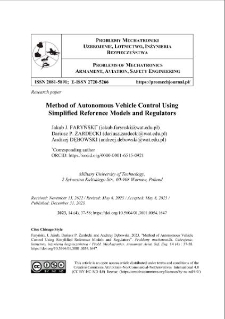Nasza Biblioteka Cyfrowa udostępnia 1 868 obiektów cyfrowych
Obiekt
Tytuł: Method of Autonomous Vehicle Control Using Simplified Reference Models and Regulators ; Method of Autonomous Vehicle Control Using Simplified Reference Models and Regulators
Tytuł odmienny:
Metoda sterowania pojazdem autonomicznym z wykorzystaniem uproszczonych modeli referencyjnych oraz regulatorów ; Metoda sterowania pojazdem autonomicznym z wykorzystaniem uproszczonych modeli referencyjnych oraz regulatorów
Współtwórca:
Dariusz P. ŻARDECKI, Andrzej DĘBOWSKI ; Dariusz P. ŻARDECKI, Andrzej DĘBOWSKI
Abstrakt:
This study contains a conceptual solution of the control method for an autonomous vehicle based on a simplified reference model and regulators. The whole issue is considered on the example of the execution phase of the lane change manoeuvre, in which the well-known 4WS (Four-Wheel-Steering) bicycle model and Kalman regulators based on the LQR (Linear-Quadratic Regulator) technique were used. The overall developed control mechatronic system was subjected to simulation studies in Matlab&Simulink. The simulation results showed correct functioning of the entire mechatronic control system and allowed us to determine further research directions. The developed control method can also find application in military vehicles.
;
This study contains a conceptual solution of the control method for an autonomous vehicle based on a simplified reference model and regulators. The whole issue is considered on the example of the execution phase of the lane change manoeuvre, in which the well-known 4WS (Four-Wheel-Steering) bicycle model and Kalman regulators based on the LQR (Linear-Quadratic Regulator) technique were used. The overall developed control mechatronic system was subjected to simulation studies in Matlab&Simulink. The simulation results showed correct functioning of the entire mechatronic control system and allowed us to determine further research directions. The developed control method can also find application in military vehicles.
Miejsce wydania:
Warszawa
;
Warszawa
Wydawca:
Wojskowa Akademia Techniczna ; Wojskowa Akademia Techniczna
Data utworzenia:
Data złożenia:
Data akceptacji:
Data wydania:
Rozmiar:
Identyfikator:
oai:ribes-88.man.poznan.pl:2688
Sygnatura:
doi:10.5604/01.3001.0054.1647 ; doi:10.5604/01.3001.0054.1647
ISSN elektroniczny:
ISSN drukowany:
Język:
Licencja:
kliknij tutaj, żeby przejść ; kliknij tutaj, żeby przejść
Właściciel praw:
Wojskowa Akademia Techniczna ; Wojskowa Akademia Techniczna
Strona początkowa:
Strona końcowa:
Tom:
Czasopismo:
Słowa kluczowe:
mechanical engineering, autonomous vehicle, 4WS vehicle, lane change process, bicycle model ; mechanical engineering, autonomous vehicle, 4WS vehicle, lane change process, bicycle model
Kolekcje, do których przypisany jest obiekt:
Data ostatniej modyfikacji:
16 paź 2025
Data dodania obiektu:
16 paź 2025
Liczba wyświetleń treści obiektu:
0
Wszystkie dostępne wersje tego obiektu:
https://ribes-88.man.poznan.pl/publication/3021
Wyświetl opis w formacie RDF:
Wyświetl opis w formacie OAI-PMH:
| Nazwa wydania | Data |
|---|---|
| Method of Autonomous Vehicle Control Using Simplified Reference Models and Regulators | 16 paź 2025 |

